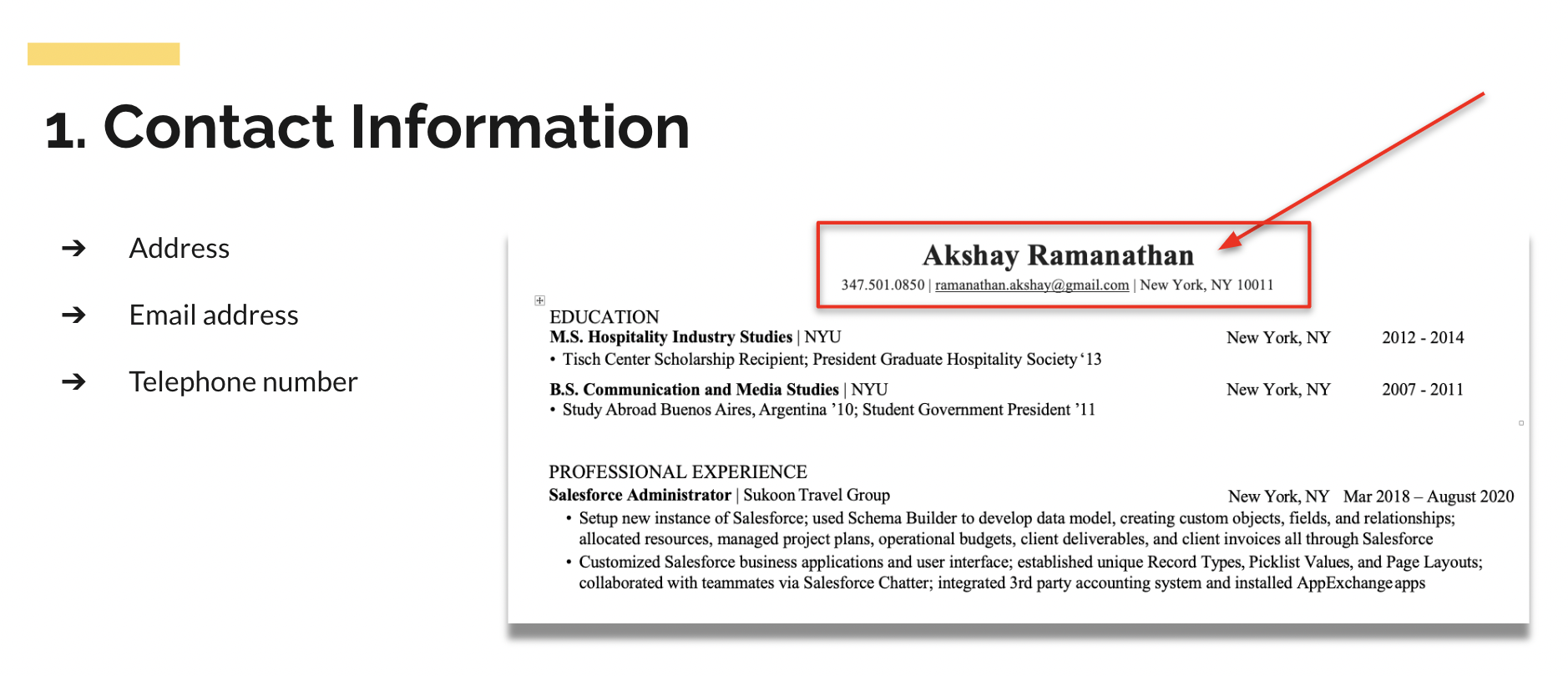What Information Should You Include In Your Resume
Especially if you are starting your career journey, resume writing can seem complicated and intimidating. Because resume readers spend just a few seconds reviewing them, a disorganized resume can immediately disqualify you from consideration, even if you have relevant experience.
Knowing where to start, what information to include, and how to best present your content can make or break your job search. That’s why it's necessary first to understand how to structure your resume.
Structuring your resume correctly will increase your chances of getting an interview, help you stand out from other candidates, and enable your resume to be easily read by Applicant Tracking Systems. In addition, the structure is also vital for these reasons:
Strong First Impression: A well-structured resume demonstrates that you are a professional and take the job application process seriously. It creates a positive first impression on hiring managers and increases your chances of getting an interview. This impression helps build the foundation of your brand. Highlighting your specific and unique skills and experiences will differentiate you from other candidates and make you more attractive to potential employers.
Clarity and Organization: Your resume should be tailor-made for the roles or specific jobs you are applying for. Generic summaries will get thrown out. Clear and organized outlines make it easy for hiring managers to identify the most critical and relevant information quickly. This can help them evaluate your qualifications and experiences more efficiently.
ATS Compatibility: Many companies use Applicant Tracking Systems (ATS) to screen resumes. If your resume is not structured correctly, it will not be scanned correctly by the ATS, and your application will be rejected.
The Most Common Resume Type: Reverse Chronological Order
Before we jump into the major sections a resume should include, let’s quickly touch on the most popular way people organize their resumes. This layout referred to as “Reverse Chronological Order,” is the most common resume format where jobs are listed starting with the most recent first. I have listed my current or most recent position first and then each subsequent one going backward in time.
It's important to note that there are other formats, such as Functional and Combination, which can be suitable for specific situations. Still, the Reverse Chronological format is the most widely used and ideal for most job seekers.
The standard Reverse Chronological format has several benefits:
Emphasizes recent experience: This format places the most recent experience at the top of the resume, which is what most hiring managers are looking for. It allows them to see a candidate's most recent and relevant experience quickly. The reverse chronological format allows job seekers to highlight their achievements and accomplishments in each position, which can help them stand out from other candidates.
Easy to read and understand: By listing the most recent experience first, candidates can establish their career progression and show how they have advanced in their field. This format is easy to read and understand, allowing hiring managers to identify essential information and quickly evaluate your qualifications.
Suitable for most industries: The reverse chronological format is ideal for most industries and experience levels. It can work for entry-level, mid-career, and executive-level job seekers. The reverse chronological format is the most commonly used, and it's the format that most hiring managers are used to seeing.
The 5 Main Sections Your Resume Should Have
When writing or revising a resume, I follow a simple 3 step framework called “Structure, Format, Content.” The first part of this framework addresses “Structure.” When I talk about the structure, I am referring to the presentation and organization of these 5 main sections of information:
Header: contact information such as name, address, phone number, and email
Summary: a statement that provides a brief overview of your career goals and qualifications
Experience: a chronological list of your past jobs, including job titles, companies, and responsibilities
Education: a list of your educational qualifications, including degrees and any relevant coursework or certifications
Skills: a list of your relevant skills and certifications, such as technical expertise or language fluency
Additional sections: add any other information relevant to your job searches, such as volunteer experience, published word, or special awards and recognition.
Display Your Contact Information
Your contact information needs to be clearly displayed and easily readable. You want to make it easy for someone to contact you if they think your skills and experience align with a job opportunity. The top of your resume or cover letter should feature your name, address, and email or phone number where you can easily be reached. Some also choose to include their LinkedIn URL. Also, be sure to have a professional-sounding voicemail. People still leave voicemails.
Include Your Educational Background
College degrees are required for most entry-level positions. Therefore it's important to establish that you are a qualified candidate by showing your high school, college, and post-graduate degrees. It serves as a great launching point when telling the story of your career.
I have included the university I went to and the degree I earned. In this case, I attended New York University, where I completed my BS in Communication & Media Studies and my MS in Hospitality Industry Studies. I also listed below extracurricular achievements, including a scholarship I earned, where I studied abroad, and that I held the position of class president. These details often spark great conversations.
Detail Your Work Experience
Your work experiences make up the most significant part of your resume. This includes your job titles, company names, responsibilities and results. You will list each position you have held, the location, and the start and end dates of employment. The key is to have strong bullet point descriptions of your tasks and responsibilities.
Add A Unique Section
Including a small “interests” section or one that mentions your extracurricular activities is highly beneficial. Listing something you are passionate about and participating in actively can communicate much to a potential employer. It provides hiring managers a glimpse into your personality, which can help them understand who you are and how you might fit in with the company culture.
It can make your resume more memorable to hiring managers reviewing candidates with similar qualifications. And if the reader shares that interest, then an instant connection is made!
So if you have participated in or held a leadership position in a school club or professional association, you should list it under an appropriate heading. I wanted to include a section called “Community Leadership,” where I have put information about my volunteer work experience.
Include Specific Certifications & Skills
My Salesforce Administrator certification was among the first professional credentials I received. I proudly shared this on LinkedIn, where I also had the opportunity to add it to my profile. LinkedIn allows you to upload your credential and verify their authenticity based on your specific id. Whether we work in IT or not, technology is part of all our jobs.
With so many online resources, ambitious professionals are teaching themselves new skills. You can include technical skills such as coding or software development and soft skills such as negotiation, research, and business analysis.
Adding A Summary Statement Is Very Helpful
As my career has evolved and my suite of skills has grown and sharpened, I have found that a summary statement is beneficial in conveying the value I can bring to individuals and organizations. It's a way to concisely communicate your intentions and goals so that any reader can establish whether your resume is relevant to them.
If irrelevant, it has saved them time, which is always appreciated, and established you as a clear communicator. You aim to have relevant conversations and build a network of like-minded professionals who share your values and professional interests.
Summary statements are helpful on resumes because they provide an overview of the candidate's qualifications and skills, and they allow hiring managers to understand the candidate's value proposition quickly. A well-written summary statement can help to grab the hiring manager's attention and make a positive impression, which can lead to an interview.
Here are some specific reasons why summary statements are helpful on resumes:
They show the candidate's career goals: A summary statement can show their goals and how they align with the job they are applying for. Highlight the candidate's most relevant qualifications and skills, which can help to make a strong case for why the candidate is the best fit for the job.
They make the resume more visually appealing: A summary statement can be used to break up text and create a more visually appealing layout, which can help to keep the hiring manager's attention.
They help to make the resume more concise: A summary statement can be used to condense the candidate's qualifications and skills into a single sentence or a few sentences, which can help to make the resume more concise. Focus the resume on the candidate's most relevant qualifications and skills, which can help to make the resume more targeted to the job they are applying for.
Conclusion
This is Part 1 of a 3-part series that breaks down my “Structure, Format, Content” framework. This blog covered Structure. Parts two and three address Formatting and Content. Formatting refers to the aesthetic presentation of your resume. Is it easy to follow, find key information, and what is its overall readability. Content refers to the meat of your resume, which are the bullet points describing your responsibilities and results for each job.
These two areas of focus come before addressing Formatting & Content because if your resume is poorly structured, the evaluator is not likely to move forward with your application. In the next Part of this series, I’ll dive into what specific Formatting I do to ensure my resume gets noticed.
About Akshay Ramanathan
With 10+ years of experience as a college counselor, career coach, resume writer, and corporate professional, I know firsthand the confusion and challenges both ambitious students and purpose-driven professionals face when building a career that is engaging and meaningful.
I have successfully overcome these problems myself and helped many others do the same.
Click here to book a call and learn how I’d like to help you take your career or college experience to the next level!









